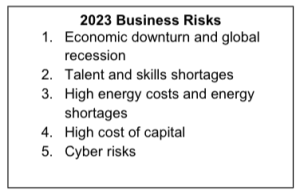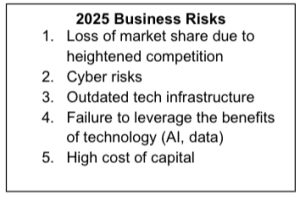Business resiliency has gained front and center attention from large corporations to smaller and medium size enterprises. Today’s economic climate is challenging for many organizations, as there are numerous risks and uncertainties that businesses must address and face. These business issues cover a wide spectrum of areas including compliance, legal, strategic, reputational, operational, human, security, financial, competition, and physical risks. Recently, a BDO business leadership survey conducted in 2023 and again in 2025 identified the following key business risks.


The key business risks from 2023 have not gone away, but there has been a shift to greater concerns about competitive threats and data storage, technology, and infrastructure issues that increase cybersecurity risks. How then can businesses continue to operate facing these potential liabilities? It is important first to discuss terminology and the difference between business continuity and business resiliency.
The definitions are similar, but they are not the same. Business continuity is the ability of an enterprise to maintain vital business functions during disruptions. A proactive strategy is developed to safeguard uninterrupted operations. Business resiliency deals with an enterprise and its adaptability and flexibility to accommodate for change, recover and regroup from internal and external challenges, and succeed in spite of unpredictable circumstances. There are three sectors of resilience that are all interlinked and include business resilience, economic resilience, and societal resilience. Economic resilience deals with the fiscal, regulatory, and governmental policies that provide for sustainable growth. Business resilience primarily focuses on organizational, operational, and supply chain strengths to address disruptions for purposeful growth. Societal resilience concentrates on welfare, education, and healthcare concerns for inclusive growth.
In the past I remember going through several business planning exercises to address unforeseen business risks and challenges. One such exercise was “disaster” planning. Other sessions focused on contingency business planning and the procedures to follow in the event of specific unpredictable situations. Another variation was scenario planning and how to operate a business given certain conditions and events. Over the years, many businesses have gotten away from disaster, contingency, and scenario planning due to the frenetic pace of business, where the only things constant are changing business conditions. However, business risks today are formidable and complex. If left unaddressed by management, business risks can result in irreparable damage to the business model.
So what are some action steps that businesses can take to improve their overall resiliency?
- First, take a proactive approach to risk management by forming a crisis management or task force team to address all potential business issues and risks
- Generate a SWOT analysis (strengths, weaknesses, opportunities, and threats) for the company
- Review long term trends and change forces that could turn into short term formidable disruptions,such as with a business impact analysis and overall risk analysis
- Take inventory of the business processes and systems used to ensure uninterrupted business operations and determine gaps
- Prioritize needed capital investments
- Create a comprehensive resiliency plan to meet business needs that could include a business continuity plan, a crisis management plan, or a disaster recovery plan
- Generate specific risk and crisis management strategies
- Review action steps and methods for testing the business resilience plan and communicate with employees on a regular basis
- Provide training and education to employees as required
There are a number of important benefits that can be attributed to successful resiliency planning:
- Adapting to changing business and customer demands
- Avoiding supply chain disruptions
- Enhancing employee and community well-being
- Building trustful working relationships among suppliers and customers
- Minimizing cost burdens by investing in preventative measures
- Guarding tangible and intangible assets
- Protecting core values and creating a more resilient organizational culture
- Seizing and capturing opportunities that competitors cannot pursue
A local business president advised that a key strategy is to set benchmarks that trigger an action, especially when you are in the heat of the battle. There are benchmarks for survival or severe crises. There are also benchmarks that can be set where adjustments can be made to maintain or change a business course of action.
“Resilience is built by putting one foot in front of the other. Even when we fear the steps, we take the step” – Martin Luther King Jr.
Sources:
- Techtonic States- Resilience is the New Business Edge, BDO
- Resilience for Sustainable, Inclusive Growth, McKinsey and Company
- What is Business Resilience?- A Complete Overview, www.theknowledgeacademy.com
All the best on your sustainability journey!
Norman Christopher, Sustainable Business Practices LLC, September 2025
